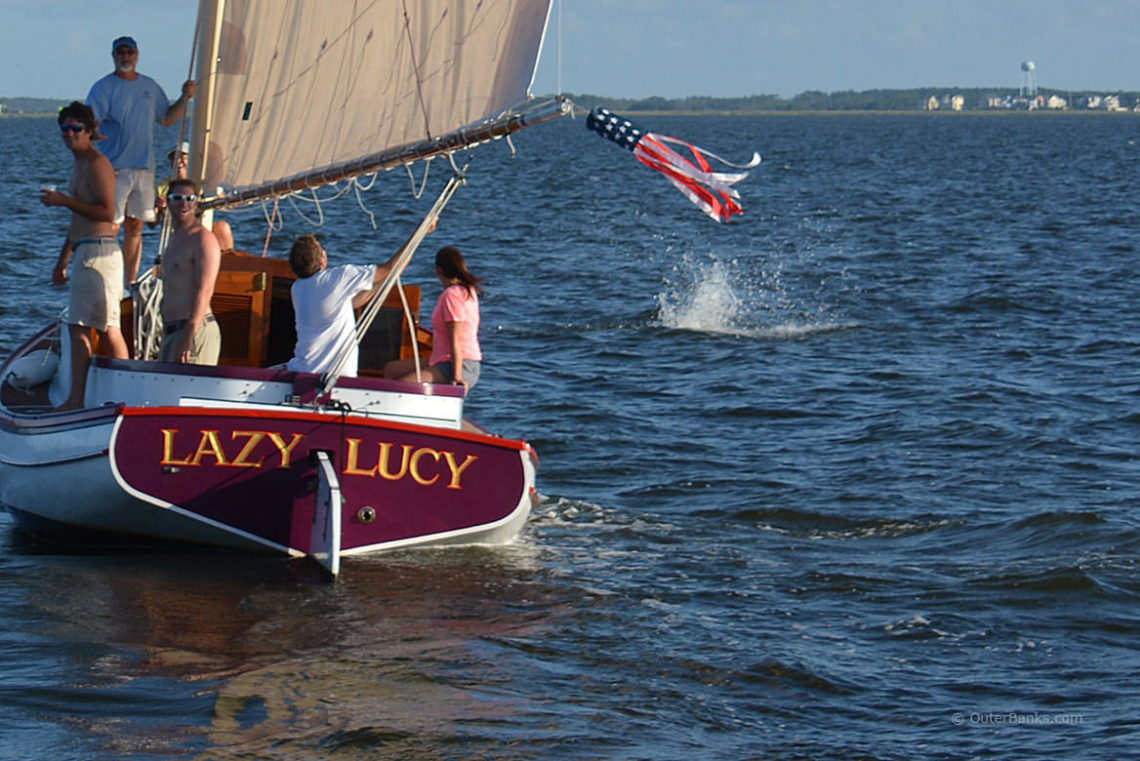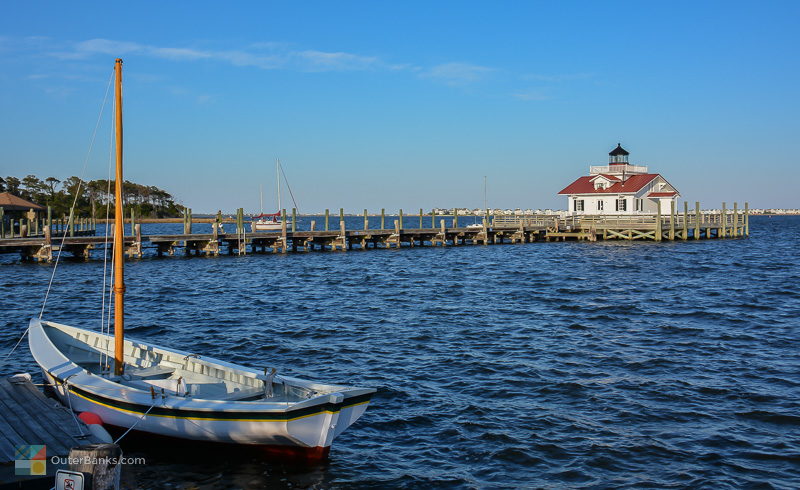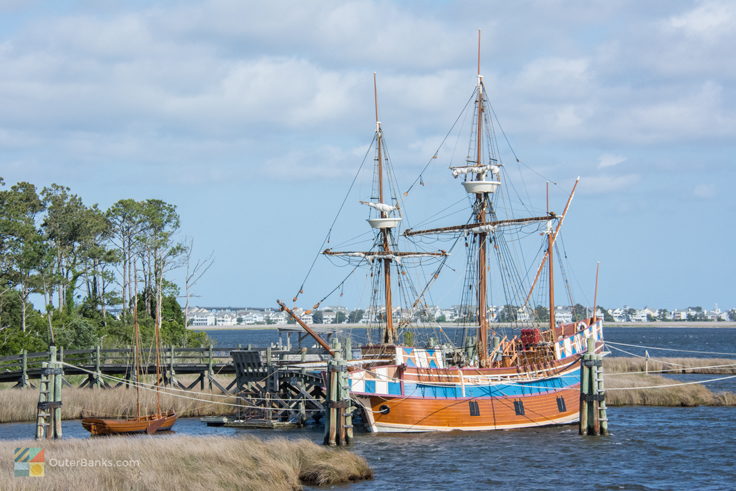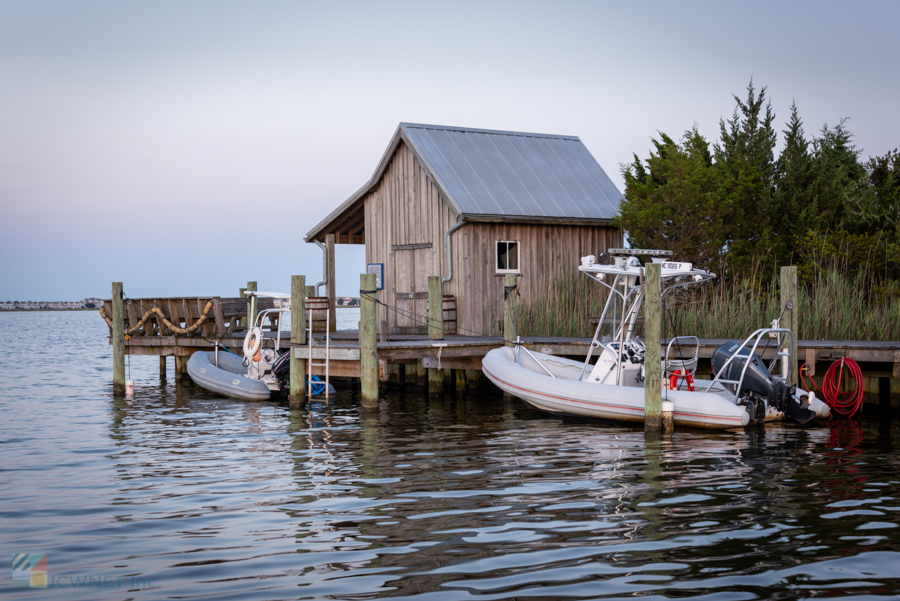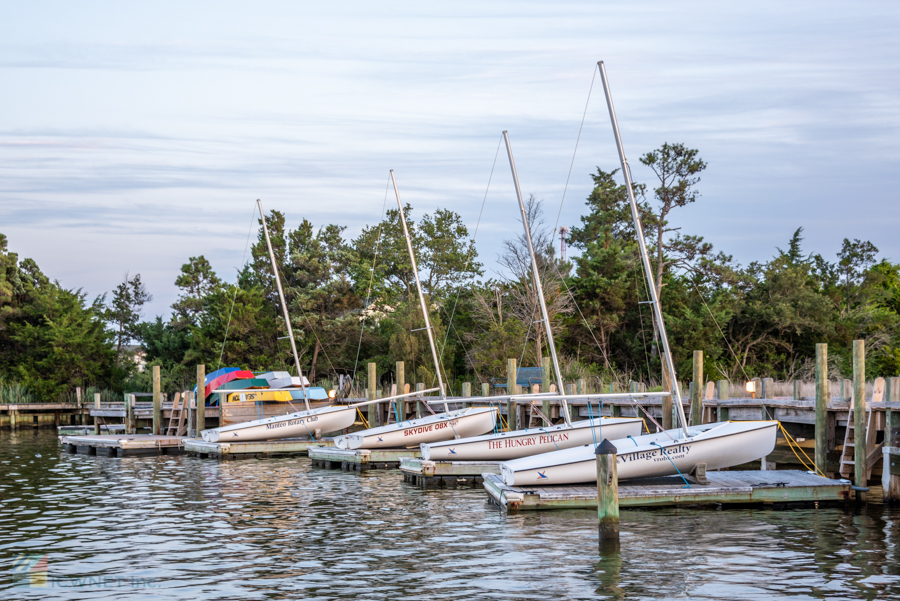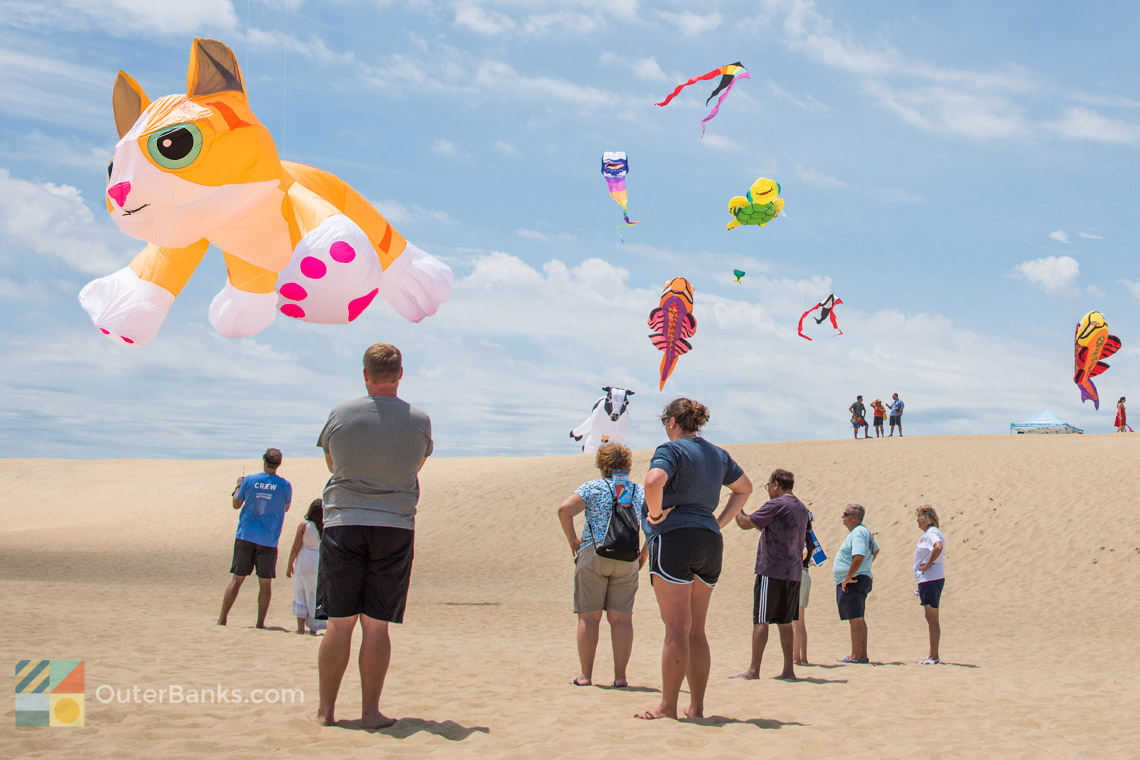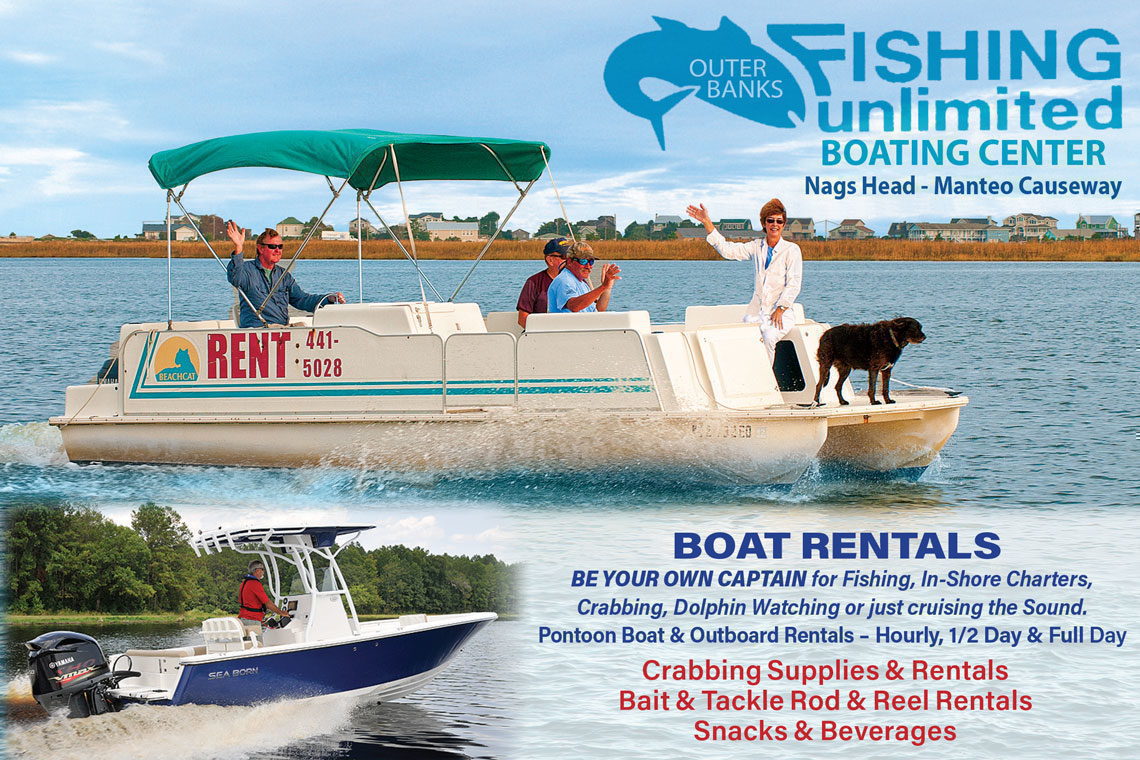The Roanoke Sound separates the central Outer Banks from Roanoke Island, and offers a wide watery playground to explore for Nags Head and Manteo visitors. Known for its exceptional saltwater fishing, its miles of safe terrain for jet skis, parasailers and kiteboarders, and its completely fantastic views that span across islands, the Roanoke Sound is one of the most visited bodies of water for central Outer Banks vacationers.
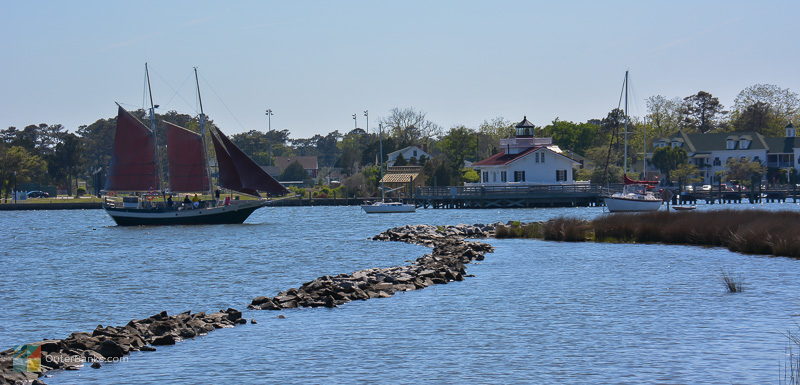
Originally an instrumental route for the East Coast's first English settlers, and still a popular destination for water lovers of all varieties, the Roanoke Sound is definitely worth a visit for anyone who loves to explore the great outdoors island-style. Grab a paddle, a skiff, or just a crab pot and a fishing pole, and head to the borders of Nags Head and Manteo to introduce yourself to this expansive and scenic body of Outer Banks water.
Geography of the Roanoke Sound
Considering that the major bodies of saltwater that border the Outer Banks' collection of barrier islands ebb and flow into each other on a daily basis, it can be hard to draw a line in the sand, (or a line in the sound), distinguishing one parcel of water from another. Take the Roanoke Sound, for example. This body of water shares imaginary boundaries with the Croatan Sound, the Albemarle Sound, the Pamlico Sound, and even the Atlantic Ocean via the Oregon Inlet, making it one of the most connected bodies of water along Eastern North Carolina.
The Roanoke Sound essentially separates Roanoke Island from the barrier island beaches, with shallow saltwater that runs approximately 3-7 miles wide. The sound borders the towns of Nags Head, South Nags Head, and a chunk of Bodie Island and the Cape Hatteras National Seashore before it joins with the Albemarle Sound to the north, and the Pamlico Sound to the south.
On the western side of the sound lies the towns of Manteo and Wanchese, which can be accessed by the Washington Baum Bridge, (better known as the Manteo / Nags Head Causeway or vice versa), which stretches across the Roanoke Sound. Bear in mind that Roanoke Island is bordered by two sounds: the Croatan Sound which separates it from the mainland, and the Roanoke Sound which separates it from the beaches, meaning that this little waterfront community is always surrounded by water.
Visitors to Manteo and Wanchese, however, are more likely to run into the Roanoke Sound as opposed to the Croatan Sound, as the Roanoke Sound flows into Shallowbag Bay which borders the popular Historic Downtown Manteo and Elizabethan era attractions, and borders the commercial and recreational fishing docks of the small town of Wanchese. Because the sound takes up so much space, and borders both sandy barrier islands and the more wooded terrain of Roanoke Island, the land bordering the sound itself is incredibly diverse. Around the sound, visitors will find wide bulk headed docks and walkways, thick marshes that are best explored by kayaks, and small sandy beaches that are virtually hidden behind the soundside of the Cape Hatteras National Seashore.
This diverse geography makes the areas surrounding the Roanoke Sound, and the sound itself, popular with virtually all kinds of specialized vacationers, including birders and wildlife lovers, fishermen, hunters, watersports enthusiasts, and historians who want to scope out the trail of the original 1580s settlers.
In addition to the larger parcels of land that border Roanoke Sound, namely Bodie and Roanoke Islands, there are also a handful of islands scattered throughout the interior of the sound's waters. Several of these parcels are large and developed with condos, homes, a world-class fishing marina, and waterfront shops and restaurants, while others are small patches of sand and marshy grasses that have barely enough room for a humble fish camp.
Whether you're spending a full day at the causeway with a fishing pole in hand, scooting across the sound waters to access the Oregon Inlet and subsequently the Gulf Stream, or just admiring a sunset from a breezy downtown Manteo restaurant, there are clearly a number of ways to enjoy this diverse body of water. Bordering a large portion of some of the Outer Banks' favorite attractions and vacation destinations, the Roanoke Sound can be explored in countless ways, with consistently fun and entertaining results.
History of the Roanoke Sound
The Roanoke Sound may be one of the region's most famous bodies of water simply because it was the route that America's first English settlers took to their new home on Roanoke Island.
The name "Roanoke," which pops up all over the East Coast in North Carolina and Virginia, is a nod to the original Native Americans that populated the island before the English Settlers arrived, the Roanoac Tribe, which was a an Algonquin-speaking community that some historians believe stretched all the way into mainland Dare County. These locals were the first residents that the original military settlers encountered during their initial 1584 expedition, and the chief of the tribe, Wanchese, actually made a good-will trip back to England and became an international celebrity in the process.
Originally, the settlers had intended to set up roots near Hatteras Island, but after several severe storms and days of rough sailing, they opted for Roanoke Island, which could be easily accessed via the deep, wide and much more navigable Roanoke Sound. Their first settlements, the military settlement and the famed Lost Colony which landed three years later, were located right on the banks of Roanoke Sound amidst live oaks and towering pine and cedar trees. This terrain made for rough travel once on land, but also provided a more than ample supply of lumber and raw materials for constructing a village.
As the centuries passed by, Roanoke Island remained inhabited, while the Roanoke Sound slowly became more narrow and shallow. The opening of the Croatan Sound to the west of Roanoke Island, (once a marshy sandbar), consequently reduced the depth and width of the Roanoke Sound and more marshes and islands popped up along the sound's borders and in the sound itself. As a result, in the 1980s, vacation and second home communities were established along these upland parcels, and more and more visitors flocked to the area, delighted by the waterfront views in all directions, as well as the boat docks and marina with easy access to the open waters of the Atlantic Ocean.
Today, the Roanoke Sound is surely a much different site than it was for the original settlers. Much narrower with development on either sides, (and even in the middle), the sound still serves as an instrumental route for commercial and recreational fishermen, and is a famed attraction for history and watersports lovers alike.
However, visitors to the Fort Raleigh National Historic Site or the Elizabethan Gardens can still get a settler's perspective as they walk through the towering pine trees and heavily forested area bordering the sound. While strolling, be sure and take in the miles of views, the gently lapping salty surf, and marvel at how for well over 400 years, this small body of water has been on the international map.
Visiting the Roanoke Sound
Clearly, the Roanoke Island Sound can be explored in a number of ways, and all a vacationer has to do to pay a visit to this area is to pick an activity or a small day trip, get outside, and enjoy.
For fishermen or visitors who want to enjoy the best views and vantage points of the sound, a visit to the Manteo / Nags Head Causeway will provide open water views in all directions. The Causeway is a bridge in between Nags Head and Manteo that spans across a series of small islands before rising above the deep channel that provides boating access for a number of charter and privately owned vessels. On either side of the bridge's arch, visitors will find public parking areas and small fishing docks and / or pedestrian bridges that are perfect for a day of fishing.
This region of the Outer Banks is especially popular with fishermen, as the proximity to Oregon Inlet and the deeper channels of waters can produce a varied range of catches. Anglers in this area have been known to reel in croaker, spot, grey trout and striped bass, and even the occasional flounder, black drum, bluefish and Spanish mackerel, making it a favorite fishing hole among the Outer Banks locals. In addition, the regions bordering the bridge are completely free to visit and fish, and present some fairly incredible views that span from the northern Outer Banks all the way to the Bonner Bridge on a clear day.
Nearby, anglers may also want to check out the Roanoke Sound Pier, a 300' foot long pier that extends into the sound and is open to visitors for crabbing and fishing. Located in a bank of waterfront shops along the causeway, and also featuring soundside boat rentals, this pier which is operated by Fishing Unlimited is an ideal destination for fishermen who love the pier fishing scene and want to try something new.
Watersports lovers will also want to hit the causeway waterfront shops to embark on some of the best soundfront adventures the Outer Banks has to offer. From this small area of shops hovering over the Roanoke Sound, vacationers can rent wave runners or jet skis, paddle boarding gear, kayaks, and even book an extended parasailing trip across the open water, or a sunset or dolphin tour.
The causeway is essentially an ideal launching point for any of these activities, as in this area of the Outer Banks, the Roanoke Sound is generally calm and easy to navigate, and borders the major soundside developments of Nags Head and Roanoke Island, presenting some pretty spectacular views of the local communities. In addition, launching a kayak or jet ski from this area delivers a rider right into the open sound waters, with no narrow channels or beaches to bypass, so the best and deepest portions of the sound for watersports lovers are literally located right off the docks.
For this reason, the causeway is also home to one of the Outer Banks' most elite marinas, the Pirates Cove marina, which is located in the center of the Roanoke Sound in between Manteo and Nags Head. Pirates Cove Marina has sponsored a number of regional and nationally renowned tournaments, including two major billfish fishing tournaments, and also has an expanse of boat slips that are available for rent or purchase.
It should be noted that the Roanoke Sound is one of the closest major bodies of water for charter fishermen in the central Outer Banks and Roanoke Island regions to access the Gulf Stream, and as a result, there are a handful of popular marinas docked along to its shores. In addition to Pirates Cove, a large number of charter businesses and charter boats can be found in the Roanoke Sound bordering the docks of Wanchese, where the run from the town's borders across the sound to Oregon Inlet is only 15-20 minutes at the most. (It's also a remarkable ride that entails gorgeous views of the local marshes and small islands, and crossing Oregon Inlet under the Herbert C. Bonner Bridge.)The Roanoke Sound channel that connects with Oregon Inlet is also deep enough and wide enough to accommodate boats of all sizes, so commercial fishing vessels prefer this route as well to access the open Gulf Stream waters.
If you prefer a slightly less active Roanoke Sound adventure, consider a stroll through Historic Downtown Manteo or any of the Elizabethan Era attractions that border the eastern and northern portions of the islands. Downtown Manteo circles around Shallowbag Bay, a watery "cut out" region of Roanoke Island that is fed by the Roanoke Sound, and the historic area offers ample waterfront boardwalks, shops, and restaurants to explore while watching the maritime activity heading in and out of the harbors.
For a waterfront dining experience, central Outer Banks visitors should also head towards the Roanoke Sound, as the Manteo and Nags Head restaurants that border this body of water are among the most established and best reviewed on the beach. A handful of restaurants are located along the causeway itself, while more can be found in both the soundside regions of Nags Head and downtown Manteo. With walls of windows or wide decks designed for outdoor seating, these restaurants provide their patrons with a fantastic waterfront meal and some of the best views on the beach.
Fishermen, watersports fans, diners, and sightseers are all welcome along the Roanoke Sound, as certain regions and areas are known for accommodating all of the above interests and more. Head to the causeway, downtown Manteo, or the soundside regions of Nags Head, and spend an afternoon, a day, or an entire week uncovering all the fun that these regions have to offer.
Tips and Tricks for visiting the Roanoke Sound
- The fantastic views of the Roanoke Sound can be enjoyed a number of ways, even if you're simply driving through along US 64 on the Manteo / Nags Head causeway. Wildlife lovers should keep their eyes peeled for snowy egrets and ibises, as well as great blue herons that make frequent appearances along the small marshy islands that pop up along the landscape. Keep a lookout, too, for the ramshackle "fish camps" that are stationed along the open sound waters. A number of these shack-style retreats are decades old, and served as rustic cabins for boaters and mariners in the area. A handful of these fish camps are still in use, and some of these islands are even for sale from time to time. Visitors who want a long-term retreat that is literally in the middle of nowhere, or curious real estate gurus who love examining unusual properties, should monitor the Outer Banks MLS (Multiple Listing Service) for parcels of these Roanoke Sound islands that occasionally come on the market.
- For an extended Roanoke Sound vacation, consider renting a vacation rental home, motel room, townhouse, or condo located along the causeway, and be completely surrounded by the open Roanoke Sound waters. These rentals can have accompanying boat slips, access to area marinas or community pools, and some of the best sunsets on the beach, enjoyed from wide, breezy decks. Located just a mile or so away from the beach, with water in every direction, these accommodations are perfect for water lovers who would prefer to be miles away from the rest of the world.
- You don't have to be an expert fisherman to enjoy the exceptional fishing to be found at the Roanoke Sound. Often all you need is a sturdy fishing pole, a little bait, and a few hours to enjoy in the public parking / fishing areas and pedestrian bridges. For a completely new way to enjoy the area fishing, try a little crabbing as well. The Roanoke Sound is a popular spot for "handlining" crabbers, who simply tie a piece of meat to the end of a string, coax the blue crabs near the surface, and then scoop them up with a small fishing net. Completely budget friendly and easy to pick up with no experience, crabbing is an activity that everyone in your group can enjoy, regardless of skill level.
- Nature lovers should look into renting a kayak from the waterfront rental businesses located along the causeway, the soundside of Nags Head, or in the heart of downtown Manteo. One of the best ways to discover the unchartered territories of the Roanoke Sound is via a kayak or canoe, and an easy-going paddle through along the perimeters of the sound will introduce visitors to acres of wild marshlands, undeveloped territory, and miles of open water views. (This is especially true along the northern borders of Wanchese, just outside the town's limits.) For an in-depth exploration that reveals the wild side of the Outer Banks, plan a self-guided kayaking tour of the Roanoke Sound.
- For a Roanoke Sound exploration that encompasses a bevy of Outer Banks attractions, take a trip to downtown Manteo, Fort Raleigh National Historic Site or the Elizabethan Gardens. All of these areas have huge parcels of soundfront land with views that extend all the way to Nags Head and Kill Devil Hills. Enjoy the vistas, as well as the phenomenal sites and attractions that make these locales vacation destinations in their own right.
It seems that the Roanoke Sound never lost its popularity since it was first discovered and utilized by English colonists in the 1580s. Today, the sound serves an abundance of recreational roles, and is the launching point for boaters, fishermen, crabbers, kayakers, paddle boarders and jet skiers from all over the central Outer Banks. Plan a fun day out on the water, or a week's vacation at one of the regions' vacation rentals, and discover why even 400+ years later, this Outer Banks body of water has never lost its appeal to newcomers.
-
Wings Over Water Encore
December 5th, 2025 - December 7th, 2025 -
Hatteras Island Christmas Parade
December 13th, 2025 2:00 PM -
The Holiday Hustle 5K & Elf Run
December 13th, 2025 11:34 AM
Wine, beer and cheese lovers will love TRiO, an exciting retail and tasting destination in Kitty Hawk. Both a gourmet retail wine, beer and cheese shop as well as a bistro with a wine bar and tap house, TRiO offers the best of the worlds of...
When most Outer Banks visitors think of Nags Head, they imagine a classic beach town filled with warm sunny days, crashing ocean waves, and miles of beaches, shops, restaurants and all the attractions that inherently come standard with an...
Owned by Garry Oliver, the proprietor of the Outer Banks Fishing Pier, this small wooden aqua blue-colored store on the Nags Head-Manteo causeway has been serving the needs of fishermen for decades. A full line of tackle is available for all types...
Take a day trip or an afternoon off the beach to explore the heart of Historic Corolla Park, and you’ll find one of the Outer Banks’ newest and most noteworthy attractions, the Currituck Maritime Museum.
